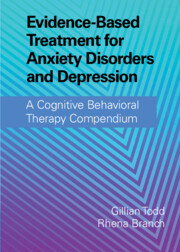 Evidence-Based Treatment for Anxiety Disorders and Depression
Evidence-Based Treatment for Anxiety Disorders and Depression from Part Three - Cognitive Behavioral Therapy for Obsessive-Compulsive Disorder and Associated Disorders
Published online by Cambridge University Press: 06 January 2022
This chapter aims to give an overview of what cognitive behavioral therapy (CBT) has to offer in the treatment of several DSM-5 “other specified” obsessive-compulsive and related disorders (OCRDs): obsessional jealousy, body-focused repetitive behavior disorders – not otherwise specified (e.g., repetitive nail biting), body dysmorphic disorder with a visible defect, and olfactory reference syndrome. Issues in diagnosis, assessment, formulation, and treatment are considered, with an emphasis on ready translation into clinical practice. We reflect not just on how traditional CBT approaches can be tailored to the unique features of each condition but also on the application and integrative potential of newer approaches, such as from the “third wave” and inference-based therapy.
To save this book to your Kindle, first ensure [email protected] is added to your Approved Personal Document E-mail List under your Personal Document Settings on the Manage Your Content and Devices page of your Amazon account. Then enter the ‘name’ part of your Kindle email address below. Find out more about saving to your Kindle.
Note you can select to save to either the @free.kindle.com or @kindle.com variations. ‘@free.kindle.com’ emails are free but can only be saved to your device when it is connected to wi-fi. ‘@kindle.com’ emails can be delivered even when you are not connected to wi-fi, but note that service fees apply.
Find out more about the Kindle Personal Document Service.
To save content items to your account, please confirm that you agree to abide by our usage policies. If this is the first time you use this feature, you will be asked to authorise Cambridge Core to connect with your account. Find out more about saving content to Dropbox.
To save content items to your account, please confirm that you agree to abide by our usage policies. If this is the first time you use this feature, you will be asked to authorise Cambridge Core to connect with your account. Find out more about saving content to Google Drive.